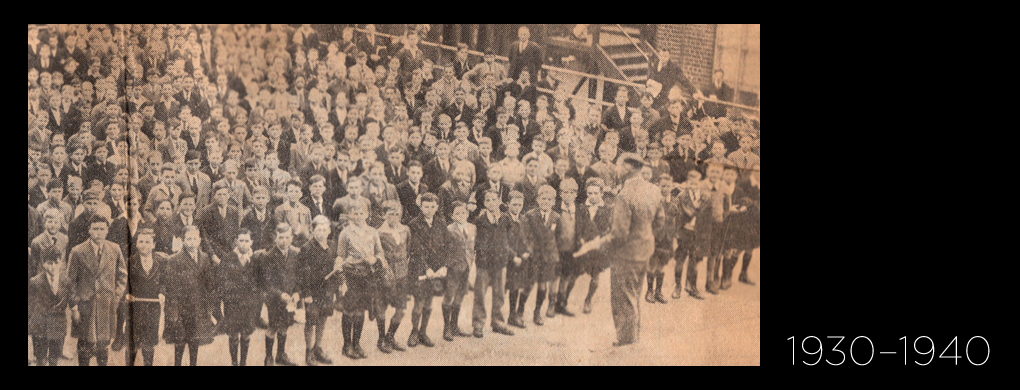70 years on and a Collingwood Tech icon is rediscovered ... in a Reservoir shed

As NMIT celebrates its centenary year, the institute is developing links with former students and staff also interested in the Institute’s history.
One such former student is Bill Gray, a Collingwood Technical School old boy (1940-42) who recently placed an advertisement in the Herald Sun seeking former staff and students with stories and memorabilia from Collingwood Tech.
Bill received a great response to his ad including a reply from mechanic and tool maker, Bill Morrison, who just happened to have a fully working Coltech Lathe – an industrial milling machine designed by Collingwood Tech teaching staff in the late 1930s renowned for its reliability and adaptability, and it even played a part in the war effort.
The COLTECH Lathe
In 1937, Federal and State Governments provided substantial grants totalling £11,000 to Collingwood Technical School for what became the Youth Employment Scheme, part of the strategy to overcome the impact of the Great Depression. Out of this, came the production of what became famous as the COLTECH centre lathe. This was a 5.25” swing lathe designed at the School by teachers. It had over 70 components and because of this, it became a useful training exercise for students to put it together.
When the war broke out, manufacture of the lathe continued. The lathe had been approved by the Commonwealth Department of Defence, an engineer from the Melbourne and Metropolitan Board of Works, and by the Education Department. As part of the Defence program, the lathe was manufactured in substantial numbers with component parts being made at many technical schools in Victoria. It was enlarged to 6” and twelve were used by the Ammunition Factory at Footscray, to ream dies for the making of bullet cartridge cases.
Design drawings for constructing the COLTECH lathe were sent to the Central Drawing Office in Maribyrnong where it was to be modified and so could be used for other purposes; drawings were supplied to other states and New Zealand.
A Collingwood Tech icon brought back to life by an industrious Scot.
Bill Morrison grew up in Rothesay on the island of Bute, off the west coast of Scotland. His grandfather was a blacksmith and Bill spent many hours in his grandfather’s smithy, learning how to work and shape metal. He was keen to follow a trade, but in his last year of primary school Bill was channelled into a Commerce stream with French language.
Despite his vigorous protests, Bill’s parents refused to allow him to move into a trade stream at school but after several wasted years, where he particularly disliked French, he left school and began an apprenticeship on the island as a motor mechanic. There was no formal training; you learned on the job, and he was in his element.
The Coltech lathe still useful 70 years after its initial manufacture
In 1980, after 25 years as a motor mechanic, Bill moved into maintenance, fitting and repairing general machinery. He used his mechanical knowledge to make his own tools and to this end, he needed a small lathe. Now living in Reservoir, Melbourne, he searched the pages of the Trading Post to see whether there was a suitable, affordable lathe. There was a lathe advertised in Doncaster for $350, approximately one third of the price Bill expected to pay for a metal lathe at that time, so he went to see it, expecting to find that the advertised price was a mistake. The owner’s father had bought the lathe complete, but disassembled and in boxes, intending to turn it into a production lathe, but this never eventuated and the son was ready to move it on. He described it as ‘a basic lathe with no automatic function and no thread-cutting capability’.
The lathe was much bigger than Bill expected, and he was unaware of the iconic status of the COLTECH LATHE in the history of Collingwood Technical School. The bronze plaque on the frame described it as a 6 SPEED GEARED HEADSTOCK LATHE ~ MANUFACTURED BY COLLINGWOOD TECHNICAL SCHOOL.
A robust, simple and adaptable lathe
Bill saw a robust, simple lathe that he could turn to many uses, so he bought it and began the laborious task of reassembling and restoring it. He has commented that apprentices must have been involved in its manufacture, because of telltale signs of inexperienced workmanship; too much pressure had been applied without soft heads on tools, leaving a definite impression on the steel.
It is now 25 years since Bill acquired it and the lathe is running smoothly in his workshop in Reservoir, where he uses it to make specialised tools to work on cars, seamlessly combining his 25 years experience as a motor mechanic with his equally long career as a maintenance fitter, repairing general machinery. His grandsons are the beneficiaries of his knowledge and expertise. Concerned that they were not learning practical skills at school, Bill has bought two old, Russian cars, Ladas, and is teaching the boys to disassemble and repair them, making his own tools, as needed, on his COLTECH LATHE.
Two generations on from its initial design and manufacture, the COLTECH LATHE, in the excellent tradition of Collingwood Technical School, continues to fulfil its primary role in the technical education and training of young people.
Bill Gray
Bill Gray attended Collingwood Technical School from 1940 to 1942. He was in the school band and later became a school prefect although, to his shame, had to hand in his prefects badge when he was caught smoking at school – a somewhat understandable misdemeanour given that Bill’s father was a tobacconist! Bill’s time at CTS enabled him to start work as an apprentice electrical fitter and armature winder. He returned to CTS to finish his apprenticeship course as an evening student. Bill is passionate about CTS history and has contributed material to the newly established NMIT historical archive.